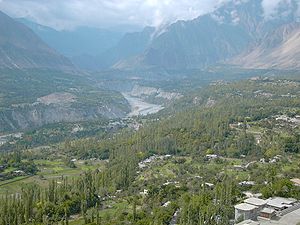| Revision as of 18:55, 22 July 2008 editSer Amantio di Nicolao (talk | contribs)Autopatrolled, Administrators6,318,135 editsm clean up and re-categorisation per CFD using AWB← Previous edit | Revision as of 19:38, 13 September 2008 edit undoTopoCode (talk | contribs)1,019 edits -Category:Valleys of PakistanNext edit → | ||
| Line 51: | Line 51: | ||
| ] | ] | ||
| ] | |||
Revision as of 19:38, 13 September 2008

Nagar (Urdu.نگر) is a town near to the Gilgit and Hunza valleys in the Northern Areas of Pakistan. The town is located in Gilgit District and was the capital of the former State of Nagar.
Today, the famous Karakoram Highway crosses Nagar, connecting Pakistan to China via the Khunjerab Pass. The road follows the Hunza river for some distance through Nagar and into the Hunza region.
Location

The Nagar valley is situated at an elevation of 2,438m (7,999 feet). Nagar Khas is the main town and the capital of the former state of Nagar. Ghulmet, Minapin, Chaprote and Hopper Valleys are popular tourist attractions in the Nagar region because of the spectacular scenery of the surrounding mountains such as Rakaposhi at 7,788m (25,561 feet), and Diran, and Spantik peak (Golden peak.)
Early history
Nagar and Hunza were originally one principality known as Buroshall, with the capital at Capal Dongs . After the reign of Miyor Khan, his sons divided Buroshall into Nagar and Hunza and declared the river as the border: Muglot became the king of Nagar and Kirkis became the king of Hunza.
Anglo-Brusho war
The British Hunza-Naga Campaign of 1889-1892 is known locally as the "Anglo-Brusho War". The British awarded three Victorian crosses during this campaign. The British gained control of Nagar during a battle at Nilt (Jangir-e-Laye) in 1891. The Tham (Chief) of that time Azur Khan was sent in exile to Kashmir. As a result Nagar had become a vassal of the Kashmir Durbar, but was ruled by the same royal family.
Nagar remained a principality until 1947. Although never ruled directly by neighbouring Kashmir or the British, Nagar and Hunza were a vassal of Kashmir from the time of Maharaja Ranbir Singh of Jammu and Kashmir. The Mirs of both sent an annual tribute to the Kashmir Durbar until 1947, and the mir of Nagar, along with the ruler of Hunza, was considered to be among the most loyal vassals of the Maharaja of Kashmir.
After independence
In 1974, Zulfiqar Ali Bhutto dissolved the Princely States of Nagar and Hunza and gave democratic representation to the Northern Areas Council, now known as the Northern Areas Legislative Council.
Administratively there are two tehsils in Nagar: Nagar-1 and Nagar-2 of Gilgit District.
Geography
The state bordered the Gilgit Agency to the south West, the China in the North-Eastern and to the north and Afghanistan to the northwest. The state capital was the town of Nagar Khas (also known as Uyum Nagar, means the Mighty Nagar Empire). The First valley of Nagar is Chalt Valley near Guroo, Janglote from Gilgit and Last valley of Nagar is Hisper valley, Biafo Range that links Baltistan in Eastern range
Population
According to the 1998 census, the population of the Nagar Valley was 85,000.
Religion
The population are almost entirely Shia Muslims of the Isna Asharai sect.
Famous Peaks and Valleys
Rakaposhi and Diran Peaks are situated in Nagar-2, while Rush Lake (High altitude Wetland), Spantik, Hopper Glacier, Hisper Glacier, Bowalter Glacier and Barpu white glaciers are in Nagar-1.
Climate
The climate of Nagar remains pleasant from mid April to the end of September. The maximum temperature in summer during the day is 25°C. The weather becomes very cold during the winter, mainly from October to the end of March. The minimum temperature can be -8°C.
Rakaposhi Community Park
The whole of Nagar has been declared a "community park" by the people of Nagar to preserve endangered species such as the marco polo sheep, brown bears, and snow leopards.
References
- Leitner, G. W. (1893): Dardistan in 1866, 1886 and 1893: Being An Account of the History, Religions, Customs, Legends, Fables and Songs of Gilgit, Chilas, Kandia (Gabrial) Yasin, Chitral, Hunza, Nagyr and other parts of the Hindukush, as also a supplement to the second edition of The Hunza and Nagyr Handbook. And An Epitome of Part III of the author’s “The Languages and Races of Dardistan.” First Reprint 1978. Manjusri Publishing House, New Delhi.
- Where three Empires meet by E.F.Night.
- Buroshall Say Nagar Tak ka Safar by Mohammad Ismail Taseen.
Brushaal Ke Qabail by Syed Yahya Shah